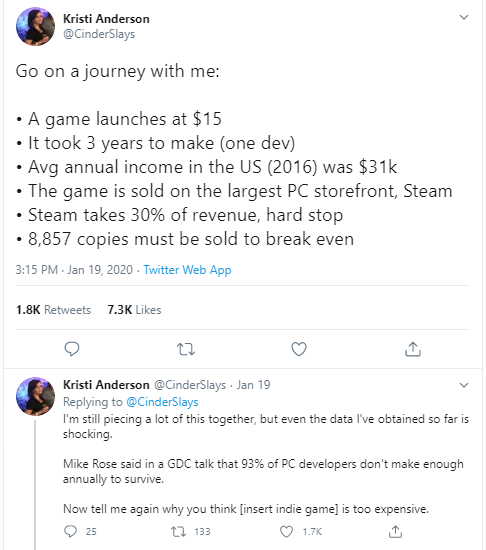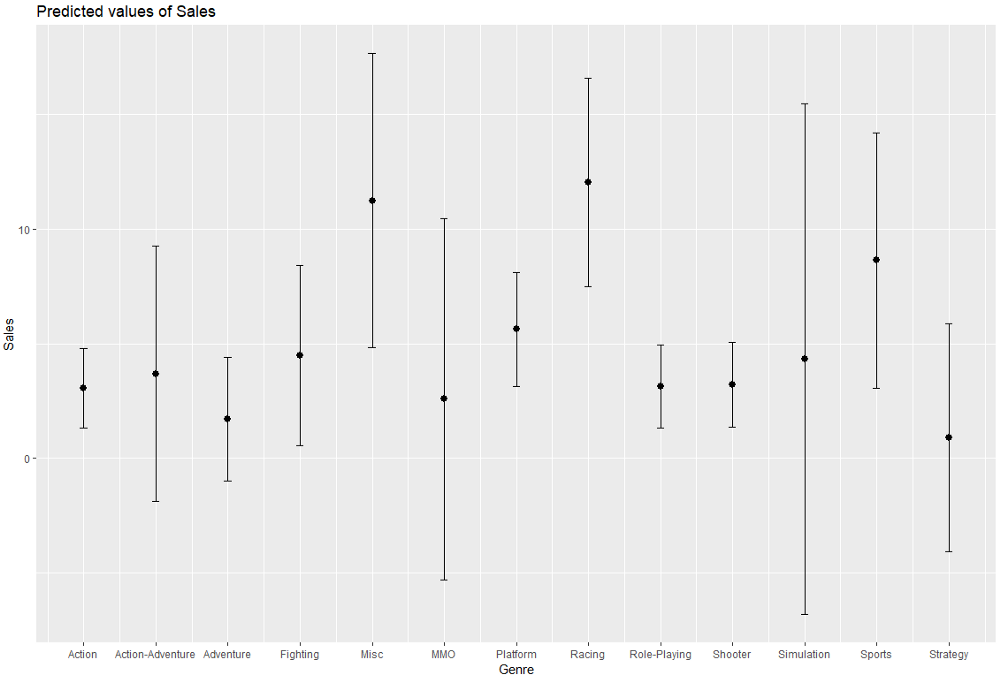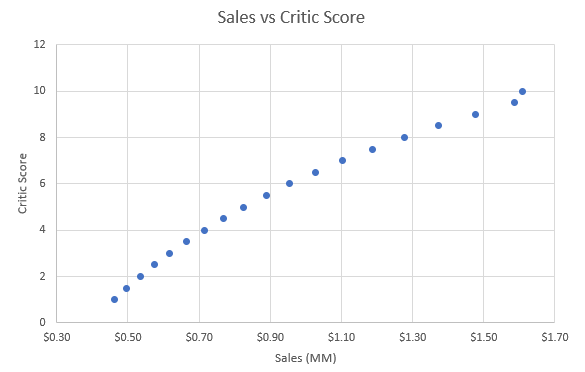I could not get this exchange between JK Rowling and Elon Musk from yesterday out of my head.

For whatever reason, I then remembered something I had seen back in January (feels like years ago) of a thread discussing the price of indie video games. Kristi (@cinderslays) broke down the deflation in PC game prices that have occurred over the past several years.

She then breaks down the stats for 3 indies in a PC Mag article. The economics of video games have become increasingly cutthroat over the past two decades. Also, video games are a product that produces value over time- it’s not like food or clothing, with immediate gratification, so it almost acts somewhat like an investment of sorts (20+ hours for $15).

I then remembered seeing this tweet from Brett, on the same day. Regarding someone using video games as currency, almost like they were an investment.

So at 11 pm on a Saturday night, I got this thought stuck in my head. Bitcoin is being discussed by JK Rowling and Elon Musk. A viable option for a future and current mode of exchange, for some. And Brett had posted something about using a video game store as a bank.
So I wanted to know – what would video games look like as an asset?
The whole premise above Brett’s tweet is that the user goes to Game Stop, reserves X amount of games, and then collects upon those games before they release. At the time of posting, 2014, GameStop charged no cancellation fees.
There are benefits to using GameStop as a store of value for this particular person. It’s quicker and more efficient for them. However (of course), GameStop is not FDIC insured, is not open 24/7, is not governed by banking regulations, and is not an actual bank (and the post itself is probably facetious)
Obviously, all of this is hypothetical.
But what if it wasn’t?
An Analysis of the Video Game Industry
Using data from Kaggle, I did a quick look into the video game industry in R to get a sense of where the most valuable games would be coming from. Nintendo is the top publisher, followed by Sony and Activision.

I also wanted to see the relationship between User Score and Critic score. This is the main predictive tool in determining the sales of the video game. There is a 56.3% correlation between User Score and Critic Score, which is surprisingly low.

As you can see in the above graph, there were some games that absolutely bombed with Critics (Harry Potter and the Half Blood Prince, funnily enough) but were considered decent by the Users.
The two charts below show the Top 30 Games by User Score and Critic Score, respectively.

Legend of Zelda was the highest rated game between the two groups, but Sonic and the Black Knight received only a 4.8 Critic Score, but Users ranked the game at 8.5.

The below table shows the games that had the biggest gap between User Score and Critic Score. FIFA 18 was one of the most controversial games, with Critics rating it 5.8 and Users rating it 9.1, creating a 3.8 differential. Lunar: Silver Star Story was ranked 10 by Users, but only 7.6 by Critics.

The below table shows the predicted value of sales based on the game type. Fighting games and Racing games have the highest amount of sales, whereas simulation games have the most variance in sales amounts.

So I now have a baseline understanding of some of the variables that go into video game success – a lot of it is driven by platform, game type, scores, as well as publisher. In the graph below, the variance between Critic Scores for some publishers is very low (Blizzard Entertainment) for some, but very high for others (Natsume).

I wanted to do a deeper dive into these scores. What do they mean, and how predictive are they in determining the success of a game?
Please note: this analysis was just for fun and to see what modeling video games as an asset would look like. None of this is investment advice, nor should be interpreted as such.
The Relationship Between Scores and Sales
My hypothesis was the the larger the discrepancy between critic score and user score, the lower the total sales, and thus, the worst investment a game would be.
For example, Video Game A with a critic score of 10 and a user score of 5 would have lower sales than Video Game B with the same critic score of 10 and a user score of 7. Therefore, we would want to invest in Video Game B.
The difference between the two is something I’ve called “score differential”. Video Game A has a score differential of 5, and Video Game B has a score differential of 3. The lower the score differential, the higher the sales.
- Score Differential = Critic Score — User Score
The score differential and sales have a ~(20%) correlation, meaning that as sales increase, the score differential decreases. That’s logical, and follows my initial hypothesis— the games with the highest dollar amount of sales probably need both high critic scores and high user scores to be successful.
The graph below shows the relationship between the two, with most games having relatively low sales (measured in millions) and a negative score differential, meaning that Users tend to rate the games higher than Critics, most of the time.

Using Score Differential to Predict Game Sales
The Legend of Zelda: Breath of the Wild was one of the most “successful” games, with both critics and users rating the game a solid 10. Published by Nintendo in 2017, the game is rated E10, is classified as an Action-Adventure game, and was made for WiiU. It has $1.61M in Sales. The version published for Nintendo Switch received a 9.9 Critic Score and $11.68M in Sales.
According to a basic linear regression on the below variables (the qualitative variables have been factorized), a one-point increase in the critic score results in a 1.4% increase in video game sales, statistically significant at the 5% level. I took the log of sales more so for convenience – I wanted to interpret sales as a percentage output, but keep my X variable in point form due to the nature of those variables.

So based on my regression results, a 1-point decrease (increase) in Critic Score would tend to lead to a decrease in Sales- the two variables are positively correlated.
Keeping User Score constant at 10, modeling out the results would create a new set of Critic Scores, and thus a new series of Score Differentials (Critic Score — User Score) and a set of new Sales based on the score differential, as outlined below for the Legend of Zelda: Breath of the Wild.

Analyzing the Video Game Market
So then the very hypothetical question becomes, what if you had invested in Legend of Zelda, before you knew the critic score?
- Let’s say that the baseline assumption was that Zelda was going to get ranked a 10 by Users.
- But the market is pricing that Critics will rank the game at 5.5, the baseline ranking (assumption)
- But you thought there was a chance that the Critics were going to rank the game at 10
- So you buy a call on the video game price because you think that the score is going to price higher than expected
I am at an extreme risk of over-complicating this article (and also modeling a video game asset market, which feels unnecessary), so I am going to do a very basic, very hypothetical example of what this could look like.
The game is currently trading at $30 – that’s the ‘stock’ price for the option, if the critics ranked the game at 5.5. Someone could buy an out-of-the-money call at the $40 video-game strike price for a premium of $2 (translating to a critic score of 8, let’s say), which would give them the option to purchase 100 video games at $40 each – a great deal, if you think that the price of the game is going to rise past $40 (if Critics rate the game higher than 5.5 points).

As we know, the critics did rate the game higher – which resulted the price of the game to increase because it was so popular (hypothetical). The price of the game rises to $50. The critics ranked the game higher than both an 8 and the 5.5 score.

Now, the call purchased has 8 points of intrinsic value (Stock Price – Strike Price – Premium Paid), and the video game investor could purchase the game at $40 per game, versus the market price of $50 per game!
Conclusion: Anything is an Investment, if you Believe
Trading video games is something that already happens – GameStop sort of (a big sort of) does what I described above, just not through calls and puts. They purchase games, resell them at a higher price, make a profit, etc.
I still don’t think that video game stores would make for a good bank (FDIC insurance goes a long way!) However, if prices did remain the same (no expected price increase) then perhaps it could be used as a decent store of value. The national average interest rate on savings is currently 0.09% APY, so it would be rather similar.
Disclaimer: The above references an opinion and is for information purposes only. It is not intended to be investment advice. Seek a duly licensed professional for investment advice.
Leave a comment